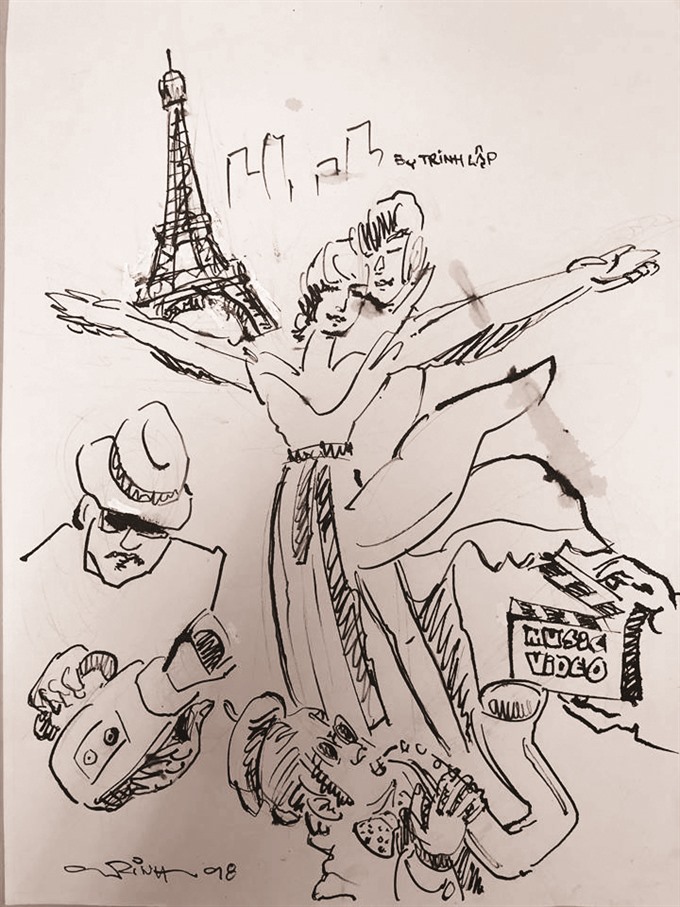 Talk Around Town
Talk Around Town

In recent years, the Vietnamese music scene, especially music for young people, has made great strides in production quality, especially music videos. In the past, music videos were simple, with the main content used to highlight vocals and music. The videos of today are very different.
 |
| Illustration by Trịnh Lập |
by Mộc Miên and An Vũ
In recent years, the Vietnamese music scene, especially music for young people, has made great strides in production quality, especially music videos.
This is an indispensable trend for artists, from senior artists like Mỹ Tâm and Đàm Vĩnh Hưng, to younger stars like Hương Tràm and Noo Phước Thịnh, in developing their images as well as elevating the quality of music videos.
In this way, it is necessary to mention the approach to producing music videos, which is constantly being perfected, in terms of content as well as presentation. In the past, music videos were simple, with the main content used to highlight vocals and music. The videos of today are very different.
"I see that music videos are now like short films, with complete stories that are consistent with the lyrical content of the song," said Nguyễn Ngọc Linh, a young music fan.
According to online news site Zing.vn, recent popular music videos have stretched up to 12 minutes, such as Hương Tràm’s Em Gái Mưa (Step Up) (9:18), Chạm Khẽ Tim Anh Một Chút Thôi (Lightly Touch My Heart) by Noo Phước Thịnh (9:10), or Đừng Hỏi Em (Don’t Ask Me) by Mỹ Tâm (11:47), and Cả Một Trời Thương Nhớ (Missing Sky) (7:00) by Hồ Ngọc Hà.
"In addition to unique and relevant content, music videos are full of beautiful imagery and elaborate post-production, which is more suited for young audiences’ tastes," Linh said.
That’s why on YouTube, these music videos rack up tens of millions of views in a short space of time. Specifically, Step Up currently has more than 110 million views, Don’t Ask Me stands at 32 million, and Lightly Touch My Heart boasts 13.5 million.
"It is actually very good for singers and their team. They make money and promote their music, then they can reinvest in better music products later. I find this very encouraging," said Trần Quang Minh, an office worker.
Pop singer Hồ Việt Trung said a music video makes it much easier for singers to attract sponsors, since it shows off the quality of the artist. “Besides, when making music videos, singers can introduce themselves to movie directors,” he said.
“The problem is that these music videos can be too long. Recently, we have fixed it by cutting the song time to under 10 minutes,” pop singer Hồ Ngọc Hà said.
However, not all viewers appreciate the trend of music video production.
"I still prefer the music videos of the old days. The singers in the past invested more in their singing because that is still the key to the quality of a singer. Music video content in the past was more streamlined. It was illustrative and a backdrop for the vocals and music," said Tô Thu Hà, a marketing officer.
Compared to old music videos, we can see a huge difference in the style of performances. All the footage, content and details of a music video are intended to highlight the vocals and emotions of the singers, thus they clarify the main content of the song. Therefore, a music product requires the singer to regularly cultivate their vocal skills, and the music video is just secondary.
"Nowadays, music videos tend to visualise music. When watching a music video that is too long, I feel like I’m watching a movie where music is secondary. I no longer realise the importance of singing, especially when the voice has been modified through a sophisticated system," Hà added.
"In addition, not every long music video is good enough. Sometimes they drag, making me bored," Nguyễn Hữu Thắng, a music lover, said.
I think it must be said that the music products of any artist, whether formal music or underground music, from artistic music to entertaining music, are the output of a process by both the team and the artists themselves.
The tastes of the audience are diverse, and each singer has their own fans with different preferences. Thus, arguing around any issues is inevitable and answers don’t come easy. These questions, in turn, motivate artists to adjust, consider and develop their products in the future, so it’s a debate worth having.-- VNS




